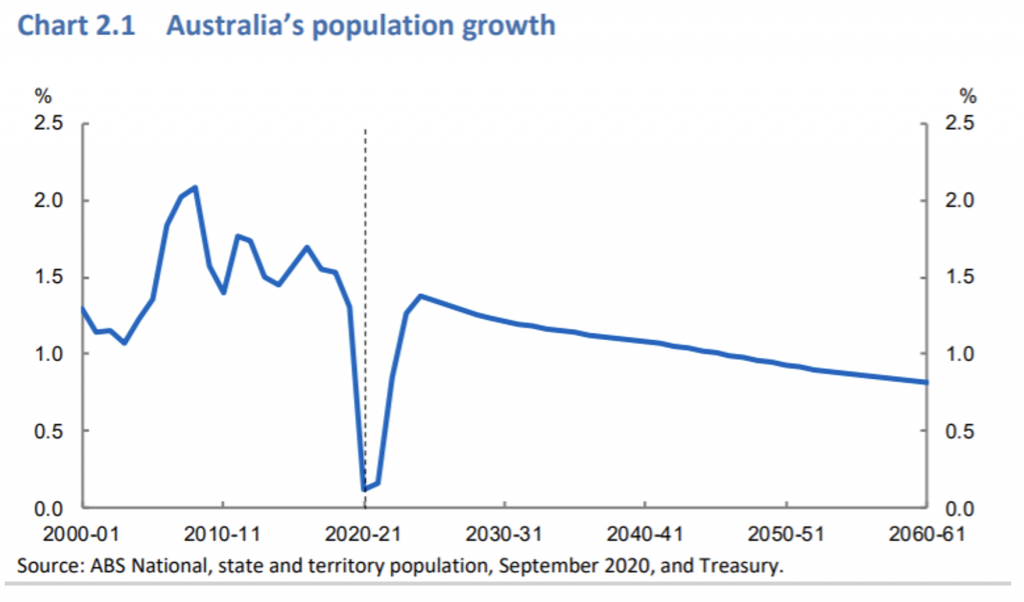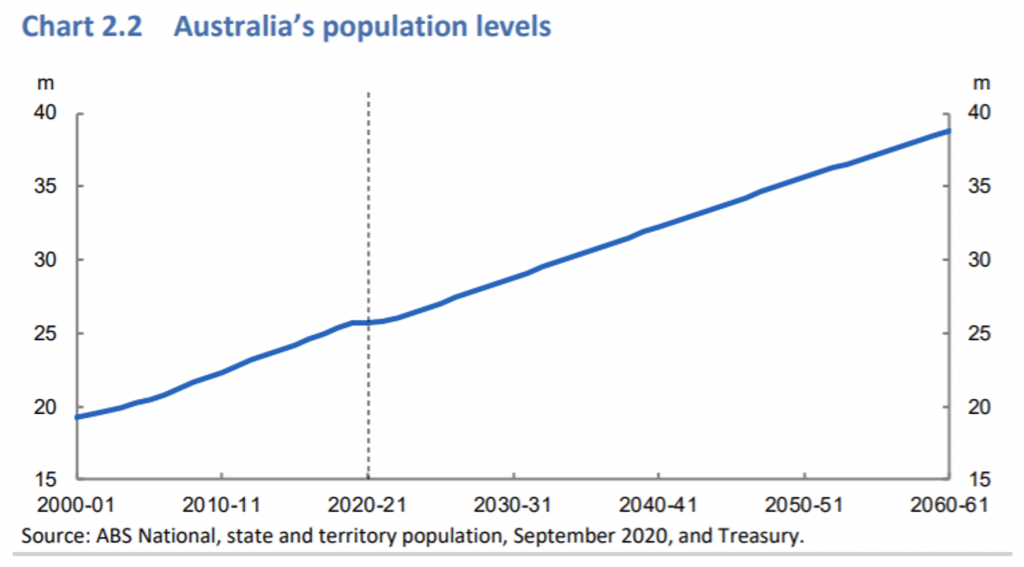
Is a high level of immigration a bad idea?
Treasury last week published the 2021 Intergenerational Report which looks at the 40-year outlook for Australia’s economy. One of its key assumptions is an expanding population, fed by high levels of immigration. But, given the downsides – like urban congestion, ecological destruction and reduced wealth per capita – is gearing Australia for a rising population good public policy?
My personal opinion is it seems rather silly to pretend that an economy like ours is forecastable with any degree of accuracy over such a timespan and any such attempt should be treated with a grain of salt. There are so many unknowable factors that over such timespans will have outsized effects that you can be very close to 100 per cent certain that you will end up quite far from the forecasts.
It is though interesting to see the underlying philosophies adopted by Treasury in coming up with their forecasts as it tells you quite a bit about the worldview of the people producing the forecast. As Treasury is also charged with advising the political decision makers on the best course of action, these assumptions are probably more likely to be reflected in public policy settings.
If we look at the assumptions regarding population growth and in particular immigration, it is clear that Treasury is still wedded to the idea that the last 20 years of very high levels of net overseas immigration is projected to continue once borders open up again as we can see from the following chart with the percentage growth returning to 1.3-1.4 per cent per year again and thereafter slightly tempering down:
We should remember that this slight tempering in percentage growth rates is on a continuously higher base number meaning that in absolute numbers, we will add about the same number of people per year resulting in a curve that is linear from the current level of around 25 million to very close to 40 million in 2060 or the equivalent of adding another current Sydney, a current Melbourne and a current Brisbane to Australia’s population:
It is interesting to compare this curve with the previous reports. From the chart, we can see that the current projections are slightly below the last few reports, mainly due to the dip in population growth we have seen during the last 15 months due to COVID-19 border closures, but significantly above the reports from 2002 and 2007 which were produced with older assumptions about lower net immigration. About 3 years ago, I looked at this change in policy in more detail in this blog post so I will not delve in details on what changed but it is clear that the people at Treasury are still predominantly occupied with headline GDP numbers rather than the arguably much more important GDP per capita number…
It is therefore interesting to see that although most economic commentators out there seem to agree with Treasury in their emphasis on the headline GDP, there are a few that are prepared to take an opposing view (which I happen to share). One prime example of that is an excellent article by Ross Gittins in Sydney Morning Herald on 5 July that raises a number of very important points, some of which I have highlighted below:
- There are sectors of Australia’s economy that are significantly less productive than in comparable countries because they are able to rely on the importation of cheap labour. Australia’s high level of immigration might in this way actually lead to lower pace of productivity improvement which is ultimately what drives increases in living standards and high levels of immigration might actually be negative for the majority of current Australians.
- Ross also points out that the report in its fine print advises that it “does not capture the broader economic, social or environmental effects of migration, such as technology spillovers or congestion.” This is a very important point as I see it:
- Environmental concerns. During the 2019-2020 drought, Sydney dam levels fell to very low levels and strict water restrictions were introduced. What had happened if the population of Sydney was 50-100 per cent higher than what it currently is? Combined with predictions of a drier climate in the future with less rainfall due to climate change, a significant higher population level could have very serious environmental effects that could significantly lower living standards.
- There is a clear “own interest” bias in the report as it only looks at the impact on the federal budget and not on state level budgets. The federal budget benefits from higher population levels as they collect income taxes, but higher population levels have a detrimental effect on state budgets as they are responsible for infrastructure investments.
- Thinking about infrastructure, the report also does not mention the negative effects that the average Australian has seen from increases in congestion, higher cost of living from higher house prices etc. that has been the result of the last 20 years high level of immigration. With immigration expected to continue at this very high rate, it is hard to see how the situation should not get worse rather than better over the coming 40 years.
In conclusion, I fully agree with Ross Gittins view and I would much prefer the policy settings in Australia to be much more focused on GDP per capita rather than on headline GDP numbers!
If we read the latest report from The Australian Population Research Institute from October 2020, it seems like most people in Australia agree with this view as we can see from this table with 72 per cent saying that Australia does not need more people:
Over time, the population’s views on this issue might filter into the political parties and we should hopefully see a recalibration of priorities.
This post was contributed by a representative of Montgomery Investment Management Pty Limited (AFSL No. 354564). The principal purpose of this post is to provide factual information and not provide financial product advice. Additionally, the information provided is not intended to provide any recommendation or opinion about any financial product. Any commentary and statements of opinion however may contain general advice only that is prepared without taking into account your personal objectives, financial circumstances or needs. Because of this, before acting on any of the information provided, you should always consider its appropriateness in light of your personal objectives, financial circumstances and needs and should consider seeking independent advice from a financial advisor if necessary before making any decisions. This post specifically excludes personal advice.
INVEST WITH MONTGOMERY


Thankyou Andreas – refreshing to read your thoughtful analysis. Over last 20 years it has seemed like a shibboleth that migration is the answer and thoughts to the contrary are heresy. And there is little recognition of the economic impact/risk analysis of unchecked carbon pollution causing catastrophic climate change +\- thawing permafrost/ feedback loops. So sad to see the consequences in Canada, North America and Europe recently. And of course the climate thermostat is set at the current amount of Co2 in atmosphere and takes decades of warming to be in equilibrium with that setting. So will get worse even if we stop polluting now and yet we continue. This will have catastrophic consequences for millions of people alive now and future generations. So much for love your fellow man. Just hope we can devise technology to draw down the greenhouse gases from atmosphere. Is there any progress on that front and any investment opportunities in that area ?
Thanks for your thoughts Sally!
There are some projects looking at drawing carbon from the atmosphere and storing it. The problem is that it is a very energy intensive process so it needs to be powered by renewable energy and as we are yet not in an oversupply of renewable energy for our daily needs, we are probably quite some way before this will become reality.